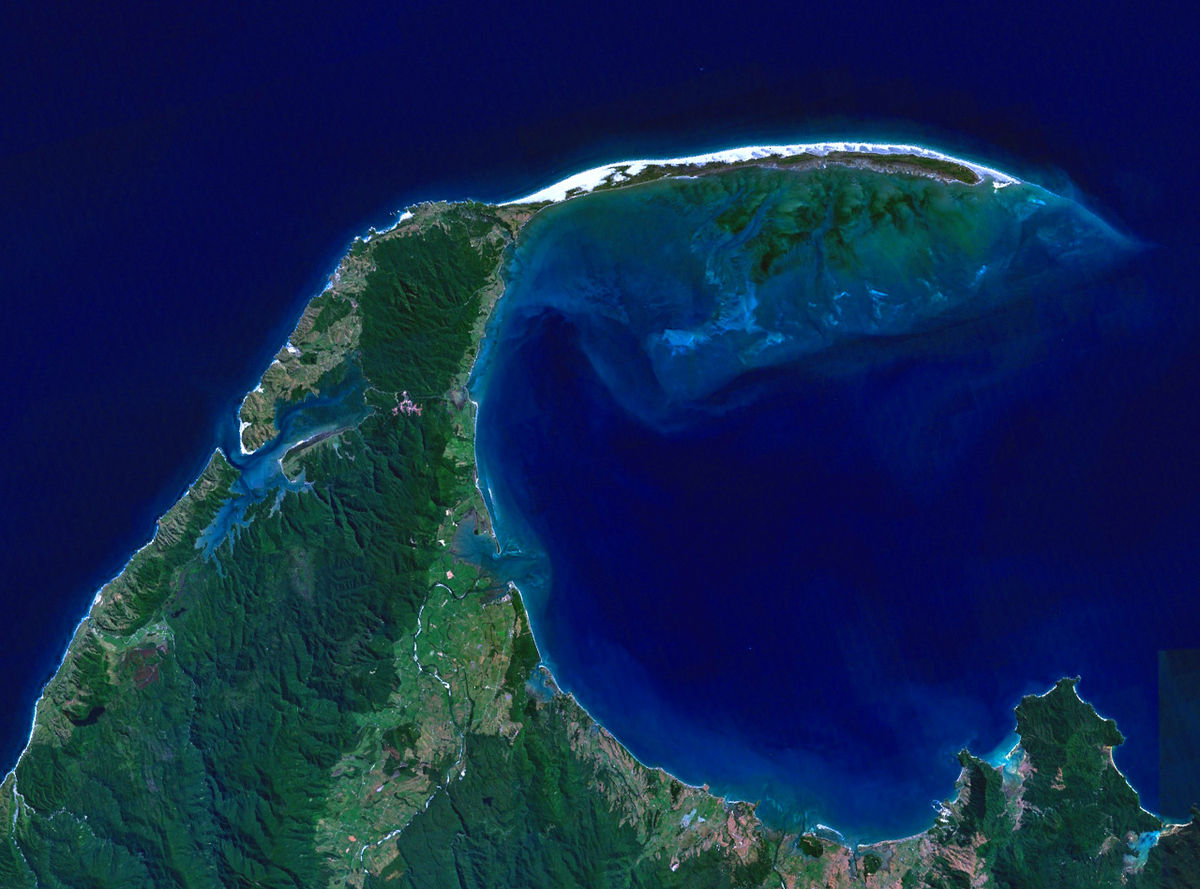Barrier Spit vs. Tombolo: Spot the Difference!
Confused about the difference between a barrier spit and a tombolo? You're not alone! These coastal landforms can look similar at first glance, but understanding their distinct formation processes and characteristics is crucial for anyone studying coastal processes or simply fascinated by the power of the ocean. This article will provide a comprehensive breakdown of these two fascinating features, clarifying their differences and helping you easily identify them in the real world.
Understanding Barrier Spits
A barrier spit is an extended ridge of sand or gravel that projects from the land into a body of water. They are fundamentally formed by sediment deposition due to longshore drift. This occurs when waves approach the shore at an angle, creating a current that moves sand along the coastline. As the coastline changes direction, such as at a bay or estuary mouth, the current loses energy, depositing the sediment and gradually extending the spit. Barrier spits are dynamic features, constantly changing shape and size in response to waves, currents, and sediment supply. According to a 2024 study by the Coastal Research Institute, barrier spits account for approximately 10% of the world's coastlines, highlighting their significant presence in coastal features.
Formation of Barrier Spits
The formation of a barrier spit is a gradual process driven primarily by longshore drift. Here's a closer look:
- Sediment Transport: Waves approaching the shore at an angle create a current (longshore drift) that carries sand and other sediments along the coastline.
- Change in Coastline: When the coastline abruptly changes direction (e.g., at a bay mouth or headland), the longshore drift current weakens.
- Deposition: As the current loses energy, it deposits the sediment it's carrying. Over time, this accumulated sediment forms a ridge extending outwards.
- Continued Growth: The spit continues to grow as more sediment is deposited, often curving landward at its distal end due to wave refraction and secondary currents.
Key Characteristics of Barrier Spits
- One end is connected to the mainland, while the other extends into the open water.
- Often curved or hooked at the distal end due to wave refraction.
- Subject to frequent changes in shape and size due to storms and erosion.
- Can provide shelter to bays and estuaries behind them.
A classic example of a barrier spit is Spurn Head in East Yorkshire, England. It's a dynamic feature constantly reshaped by the forces of the North Sea. Another great example can be seen along the outer banks of North Carolina.
Understanding Tombolos
A tombolo is a coastal landform that connects an island to the mainland or to another island. The key distinction from a barrier spit is this connection to an island, which significantly influences its formation. Tombolos are primarily formed through sediment deposition influenced by wave refraction around the island. As waves encounter the island, they slow down and bend (refract), concentrating their energy on the sheltered side. This reduced wave energy allows sediment to settle, gradually building a land bridge between the island and the mainland.
Formation of Tombolos
The creation of a tombolo is directly linked to the presence of an offshore island and the way it interacts with wave energy:
- Island Influence: An offshore island acts as a barrier to incoming waves.
- Wave Refraction: Waves bend (refract) around the island, reducing wave energy in the sheltered area behind it.
- Sediment Deposition: The reduced wave energy promotes sediment deposition in the sheltered area.
- Land Bridge Formation: Over time, this sediment deposition builds up, eventually forming a land bridge (the tombolo) connecting the island to the mainland.
Key Characteristics of Tombolos
Key traits of a tombolo:
- Connects an island to the mainland or another island.
- Formed by sediment deposition in the wave shadow of an island.
- Can be submerged at high tide (especially sand or gravel tombolos).
- Provide access to formerly isolated islands.
An excellent example of a tombolo is Chesil Beach in Dorset, England, which connects the Isle of Portland to the mainland. Another is Mount Maunganui in New Zealand, a volcanic cone connected to the mainland by a sandy tombolo. Statistics show that tombolos are more commonly found in areas with relatively low wave energy and a readily available source of sediment, further emphasizing the importance of sediment deposition in their formation.

Barrier Spit vs. Tombolo: A Detailed Comparison
While both barrier spits and tombolos are coastal landforms formed by sediment deposition, their formation processes and overall structure differ significantly. The key is understanding the role of an island in tombolo formation.
Distinguishing Features in Table Format
| Feature | Barrier Spit | Tombolo |
|---|---|---|
| Formation | Longshore drift and sediment deposition extending from the mainland. | Wave refraction around an island leading to sediment deposition connecting the island to the mainland. |
| Connection | Connected to the mainland at one end, with the other end extending into open water. | Connects an island to the mainland or another island. |
| Island Influence | Not directly influenced by the presence of an island. | Formation is dependent on the presence of an offshore island. |
| Shape | Typically linear or curved, extending from the mainland. | A land bridge connecting an island and the mainland, often wider and more substantial than a simple spit. |
| Dynamics | Constantly changing due to coastal erosion and longshore drift. | Also dynamic, but the presence of the island provides a degree of stability. |
The table above clearly summarizes the fundamental differences between these two coastal features. Remember that the presence of an island is the defining characteristic of a tombolo.
Common Misconceptions
One common misconception is that any sandy feature connecting land is a tombolo. This is incorrect. A barrier spit can enclose a lagoon, seemingly "connecting" land, but it doesn't connect to an island. Recognizing the origin and connection type is crucial.
Factors Influencing Formation and Stability
The formation and long-term stability of both barrier spits and tombolos are influenced by a complex interplay of factors. These include the availability of sediment, the prevailing wave climate, tidal range, and the rate of sea-level change. Changes in any of these factors can significantly impact the evolution of these coastal landforms.
| Factor | Influence on Barrier Spits & Tombolos |
|---|---|
| Sediment Supply | A sufficient supply of sediment is essential for the initial formation and continued growth of both features. Reduced sediment supply can lead to erosion and eventual disappearance. |
| Wave Climate | Wave energy determines the rate of longshore drift and sediment deposition. High-energy waves can erode the features, while lower-energy waves promote deposition. |
| Tidal Range | A large tidal range can influence the shape and size of both features, as well as the extent of flooding and erosion. |
| Sea-Level Change | Rising sea levels can inundate and erode both barrier spits and tombolos, potentially leading to their submergence or destruction. According to the IPCC, global sea levels are projected to rise significantly in the coming century, posing a serious threat to these coastal landforms. |
| Coastal Erosion | Erosion from storms and strong wave action can drastically alter or even destroy both landforms. Human activities, such as coastal development, can exacerbate coastal erosion. |
Understanding these factors is crucial for marine geology experts in predicting the future of these dynamic coastal landforms.
FAQ
Here are some frequently asked questions about barrier spits and tombolos:
- Q: Can a barrier spit eventually become a tombolo?
- A: It's unlikely. A barrier spit forms independently of an island. For a barrier spit to become a tombolo, an island would need to emerge or be artificially created in the spit's proximity, followed by wave refraction and sediment deposition filling the gap.
- Q: Are tombolos always made of sand?
- A: No, tombolos can be made of sand, gravel, or even shingle (small pebbles). The composition depends on the available sediment in the area.
- Q: What is the difference between a tombolo and a causeway?
- A: A tombolo is a natural coastal landform created by sediment deposition. A causeway is an artificial road or embankment built across water or low-lying ground.
- Q: Are barrier spits and tombolos permanent features?
- A: No, both are dynamic and subject to change due to natural processes like coastal erosion, storms, and sea-level rise. Human activities can also impact their stability.
Hopefully, this FAQ section has addressed some of your lingering questions. If you have more, feel free to explore academic resources for further in-depth information.
In conclusion, while both barrier spits and tombolos are fascinating coastal landforms shaped by sediment deposition, understanding the critical role of an island in tombolo formation is key to differentiating them. The dynamic nature of these features highlights the constant interplay between land and sea. Do you have any experiences with either barrier spits or tombolos? Leave a comment below and share your observations!
